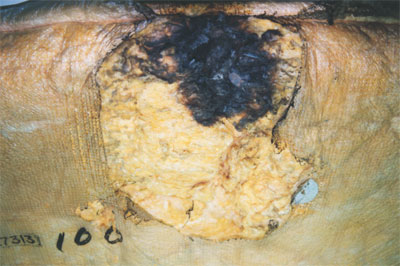Performance monitoring of the auxiliary power unit (APU) was being carried out during ground maintenance of the Boeing 737-300. Maintenance staff reported that the electrical system voltage had surged twice and that the aircraft interior lights had dimmed before voltage and frequency indications returned to normal. No circuit breakers had tripped. When maintenance personnel in the aircraft cockpit noticed a burning smell, they shut down the APU to investigate the fault.
The forward No. 2 galley ovens were found to be inoperative. During further troubleshooting, ground power was applied twice, which resulted in smoke emanating from a ceiling access panel above the forward No. 2 galley assembly.
The fault was traced to the electrical connector supplying 115VAC three-phase power to the forward No. 2 galley ovens. The connector and associated wiring behind an overhead panel were burnt. The seven-pin connector had a five-wire bundle comprising phases A, B, C, neutral D and static ground. The three-phase wires had desoldered from the pins on the connector. Arcing damage was found on the endbell and cable clamp halves of the connector.
The insulation blanket and galley panels next to the connector were blackened and heat-damaged. Charring of the insulation material had occurred over an area of about 75 mm x 100 mm. The film covering the blanket had burnt for a further 150 mm to 250 mm.
Figure 1: VH-CZB damaged insulation blanket

The galley manufacturer and operator established that arcing and heating of the connector and wiring was due to inadequate soldering and insertion of the phase wires into the connector-pin buckets. Only the static ground-wire connection was found to meet the manufacturer's soldering process standard.
The connector at the other end of the damaged cable was also examined. The solder terminations of phases A, B, C and neutral D were also found to be substandard, with solder smeared on the outside of the contact pin wall and only a small amount of solder bonding the cable strands to the contact pin.
The phase and neutral wire-identification numbers stamped on the insulation were of a different size and orientation from those supplied by the galley manufacturer (as shown on the static ground wire insulation). The wire-identification number stamps matched those held by the operator.
The arcing damage found on the endbell and cable-clamp halves of the connector had no matching wire-bundle insulation damage, showing that the damage had occurred before this incident. The resulting damage to the cable probably explains why the phase A, B, C and neutral D wires had been replaced and re-identified.
Forward No. 2 galley was the original fitment on this aircraft, delivered in September 1986. The operator reported that disconnection of the subject connector would occur only during scheduled galley removal at each D-check. The sole D-check on this aircraft occurred in July 1994. The operator reviewed maintenance and pilot discrepancies raised against electrical power and galley equipment systems since aircraft delivery, but did not find any failures requiring loom replacement. Similarly, a review of D-check work documents showed no galley electrical system discrepancies.
The insulation blanket and film-like covering from above the forward No. 2 galley were heat damaged as a result of the electrical connector fault. The operator reported that the blanket-covering material (Orco Film AN-26) did not appear to be flame retardant to the level of FAR 25.853. The operator believed that the accumulation of organic material on the surface of the film over 13 years, especially corrosion inhibiting compound mist, would have changed the film's flammability performance. As a result of the accident involving Swissair flight 111, the U.S. Federal Aviation Administration is researching the flammability of thermal acoustical insulation materials.


